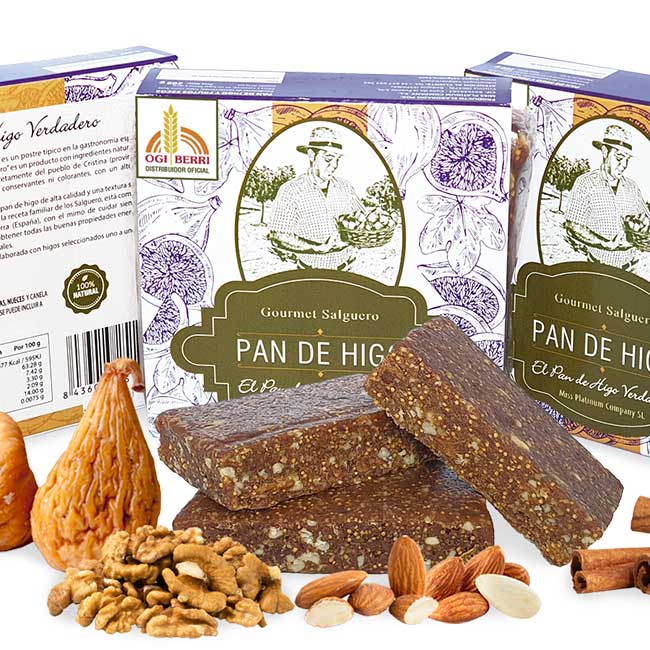.png.transform/rendition-xs/image_image%20(1).png)
Getting Figgy with it: A look at Traditional Spanish Fig Cake
Traditional Spanish fig cake or fig bread, known as pan de higo in Spain, is a sweet artisanal delicacy paired mostly with sharp tasting cheeses such as Idiazabal or Manchego, and often accompanied by a glass of wine.

Thought to have Arab roots, Spanish fig cake originated as peasant fare and was eaten by country folk who relied on it for fuel while working the fields, and it soon became a staple. Fig cake was also an effective way to preserve figs of any given harvest for the winter months and beyond. It provided a simple way to eat this highly nutritious fruit, rich in antioxidants, calcium, potassium, iron, and fiber, in the winter months when fresh fruit is typically scarce. Today, fig cake is traditionally consumed during the Christmas holidays in Spain, and hails from various Spanish regions such as La Vera (Extremadura), different areas in Andalusia as well as Aragón and Catalonia.
Although it is often described misleadingly as “bread” or “cake”, fig cake is wheat- and grain-free with no trace of butter or eggs. This traditional Spanish dessert is prepared with dried figs that are ground into a dense and compact paste, and then mixed with coarsely crushed or whole nuts (almonds and/or walnuts) making it both chewy and crunchy.
Recipes generally include honey and a variety of spices such as aniseed, cinnamon, pepper or cloves, and sometimes candied fruit. While it is it customary for fig cake to be shaped like a pressed wheel or a roll, there is also an alternate version of this sweet, which is a circular cake made of only pressed figs. Fig cake is also sold in bar form, and often commercialized as a gluten-free energy bar.
Spain is the largest producer of figs in Western Europe

Spain is the largest producer of figs in Western Europe, followed closely by Portugal and Greece. It is estimated that approximately 12,000 hectares of fig trees are grown in Spain. About half of the country’s fig production is concentrated in the autonomous region of Extremadura, specifically in the province of Badajoz, whose microclimates and soil quality greatly favour fig tree plantations. Figs are also grown in the andalusian provinces of Córdoba, Seville and Huelva, and along the Mediterranean in Murcia and Alicante and in Lleida (Catalonia).
Fig growers tend to focus on the production of both fresh figs, and dry fig products and their derivatives since there is a wide market for both. Premium dried figs are generally sold as a standalone product, but are also used to make pan de higo.
New producers like the year-old Higos Salguero, located in Badajoz, sell pan de higo in a simple format, says Lucas Benítez García, part owner and manager at the company. Opting for the energy bar format, Higos Salguero sells artisanal 50g pan de higo bars in a four-pack, and markets the bars as a nutrient-dense healthy snack for athletes. National sales are slowly rebounding, and they are hoping to have repeat sales to Morocco and Kuwait in 2021.
Other producers such as Higos El Pajarero, a family-owned company, is one of the largest fig producers in Spain and exports to other European countries such as France, The Netherlands and Denmark, and outside the European Union to Morocco and Uruguay. The company sells dried fig products of the pajarero variety, also known as calabacita, which is native to the Badajoz region. Higos El Pajarero currently produces 1.65 million kilos of figs annually.
Pan de higo is mostly sold in the fall and winter months between September and April, says Fuensanta Carrillo, the general director for the company. Their “fig and nut bread,” sold in two sizes (250g/500g), is made with conventional figs and ground nuts or whole nuts. In fact for Higos El Pajarero international sales of their fig cake outpace domestic sales for the company, says Carrillo, and they are currently working on an organic version of their fig cake, she adds.
Spanish fig cake is usually sold and paired with cheese, says Tanya Booth, owner and general manager of the Iberian product store, The Spanish Table, based in Berkeley, California. The American retailer, who has three brick-and-mortar stores in California and a successful online business selling food products from Spain and Portugal, sells their fig cake all year round with a spike in sales during the holidays starting from Thanksgiving right through to New Year’s. The product is sold paired with cheese boards and as a complementary item in gift baskets. It sells well during the holiday season, says Booth, as people entertain more, and it gains interest when promoted to customers as a healthy snack, she states.
Spanish fig cake exports

Fig cake sells very well all-year-round among customers who buy from the UK-based online store, The Tapas Lunch Company Ltd, says Hernán Silva, manager for the company. The company, which sources and imports its products directly from Spain, sees steady sales all year. However, in the last year it is wholesalers, and not regular customers, who are generating the bulk of the company’s fig cake sales, explains Silva, as the wholesalers have an in-store demand in the UK and buy from them online.
While fig cake may seem like a relic of the past to some or simply a treat eaten at Christmas, it continues to experience demand abroad. As such, fig producers are finding innovative ways to deliver new fig products or to revamp the traditional fig cake in a health bar format or by upgrading to organic figs to appeal to savvy and health-minded consumers.
Text: Nathalie Obregón

